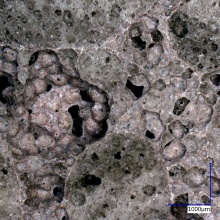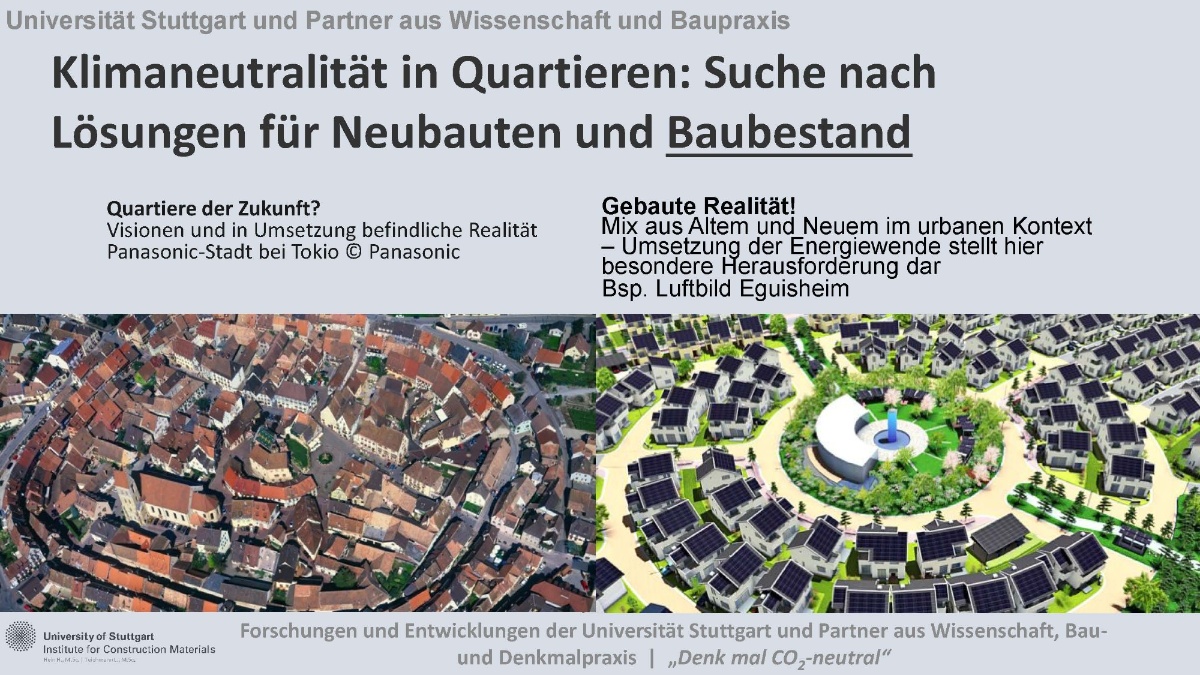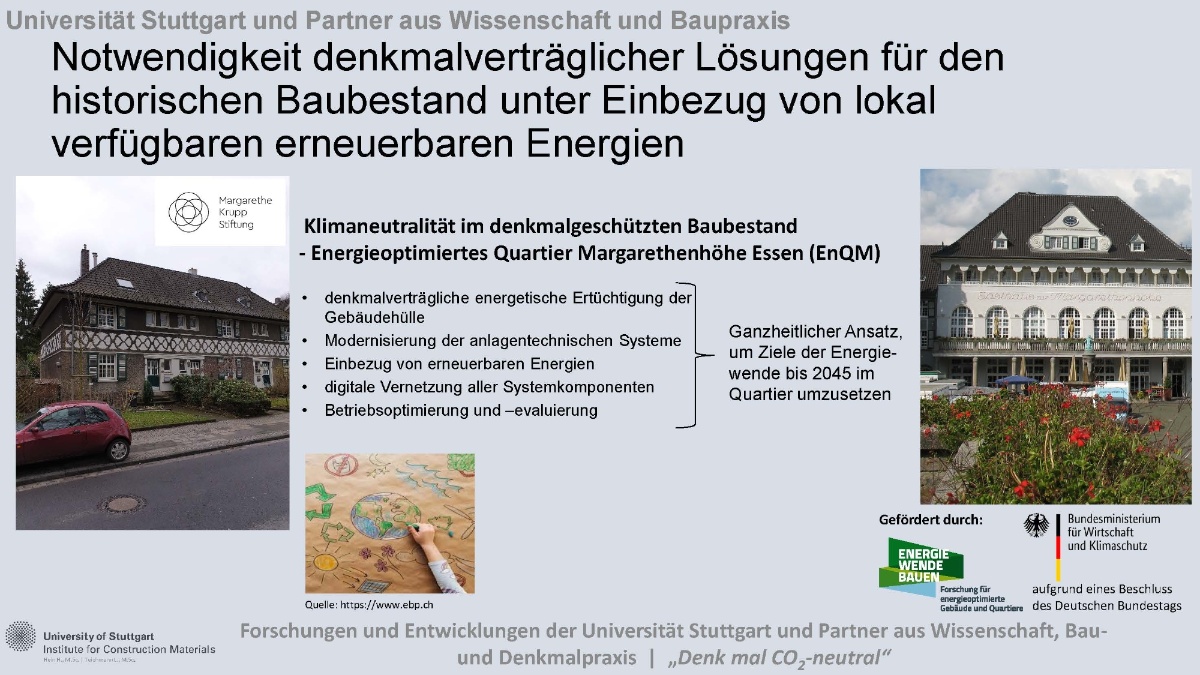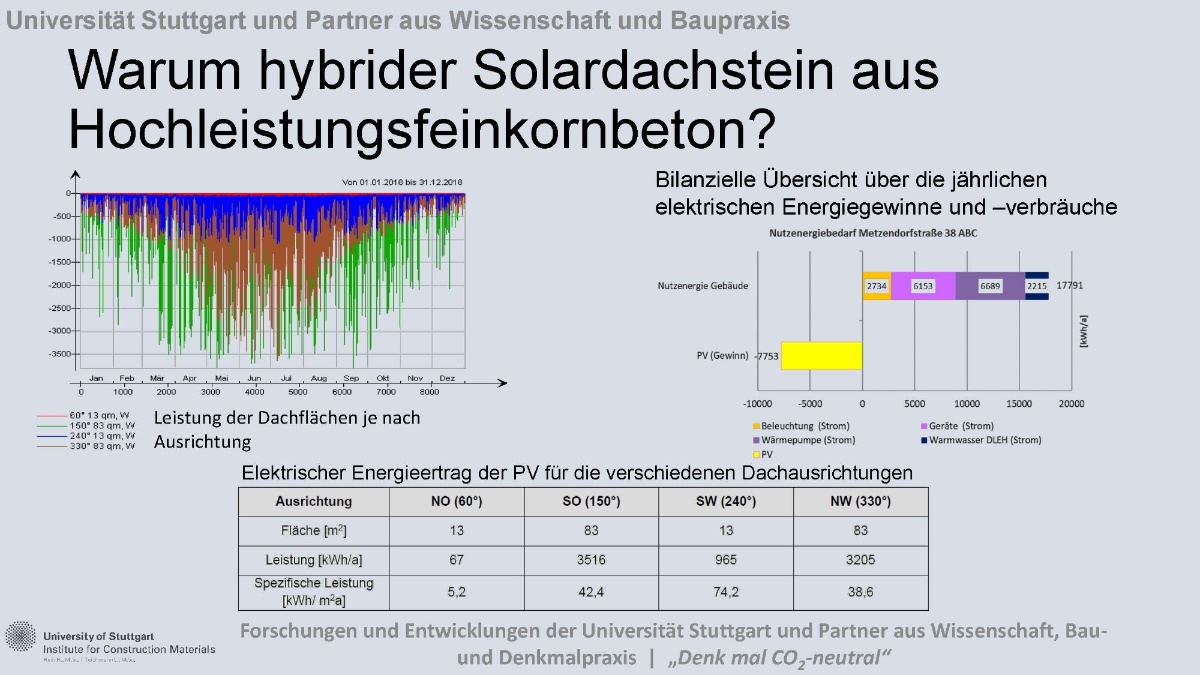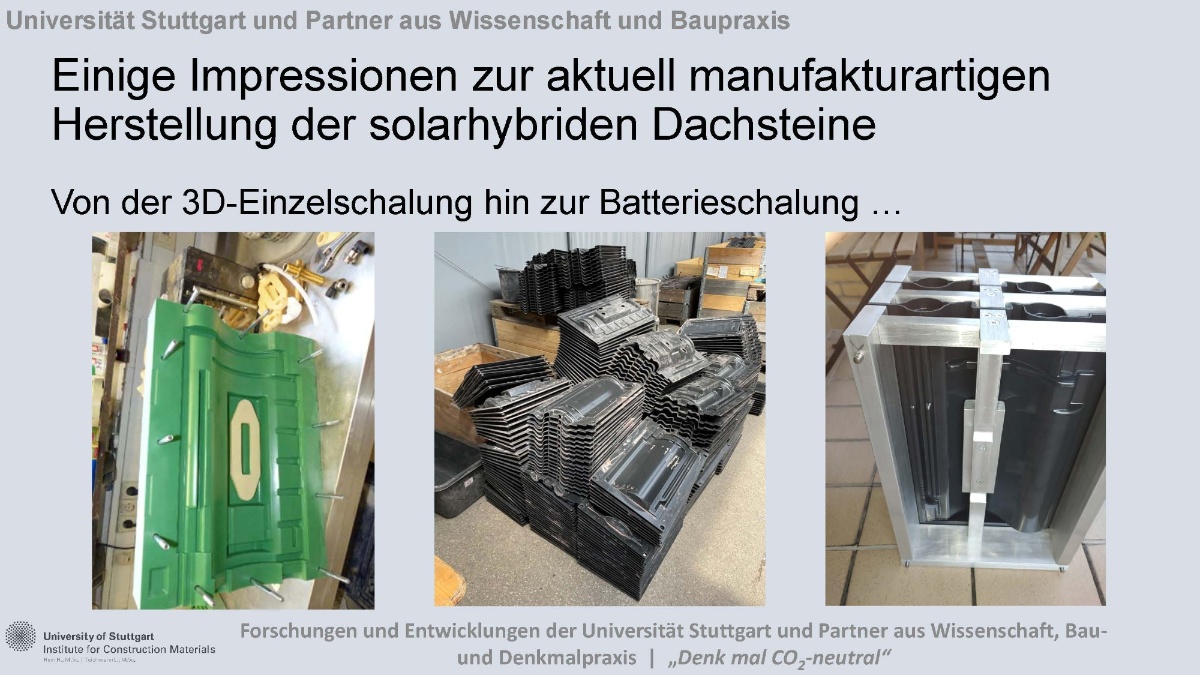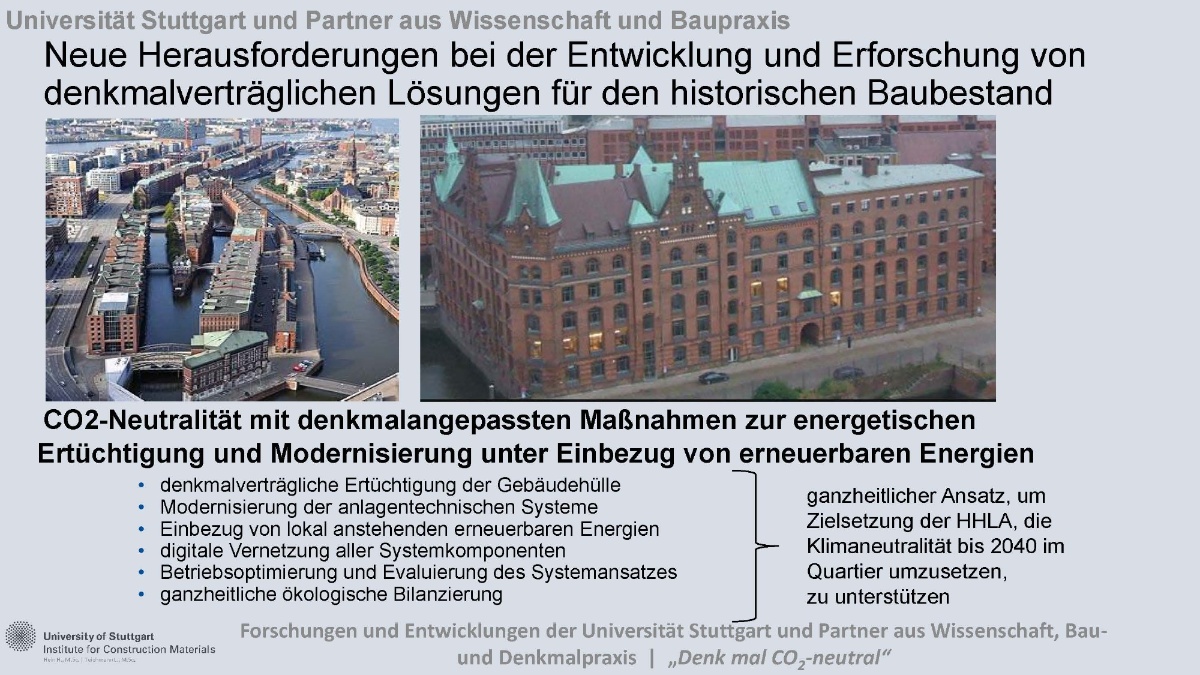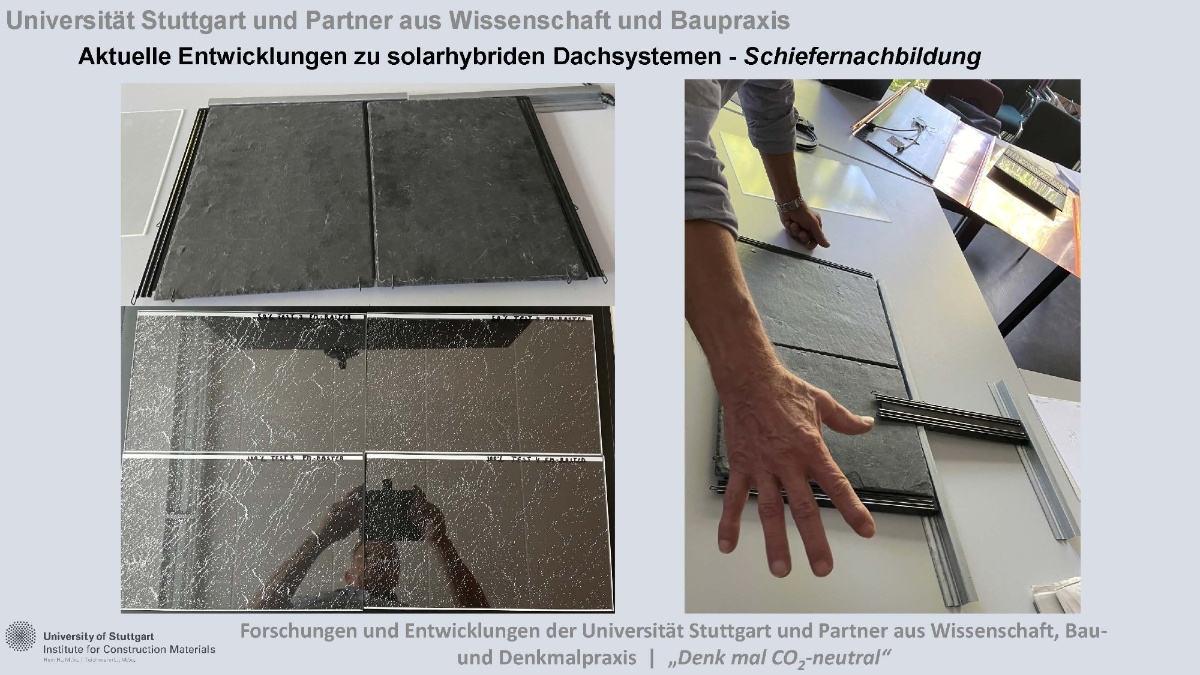An overview of some of our research projects
Joint project:EnEff:Stadt 0-CO2-WSHH - CO2-neutral World Heritage Site Speicherstadt Hamburg
Phase I (0-CO2-WSHH); sub-project: Energy and environmentally compatible refurbishment taking into account the requirements of monument protection law
The aim of the joint project "CO2-neutral World Heritage Speicherstadt Hamburg -Phase I (0-CO2-WSHH)" (BMWi funding code 03EN3027C) is to redevelop listed quarters into a virtually CO2-neutral quarter by developing a holistic energy concept, innovative hybrid roof elements, thermally activated floor slabs made of lean concrete for storage and the conversion of inner courtyards into energy gardens and intelligent electrical, thermal and digital integration.
The Speicherstadt World Heritage Site in Hamburg is used to analyse the approach, in which the innovative approaches developed in the project are to be extensively simulated by means of a series of parameter studies as well as exemplarily tested in isolated cases on demonstrators. In the process, the energy concept developed for the quarter will be holistically examined both energetically and ecologically for individual buildings as well as for the entire Speicherstadt and evaluated with regard to its climate neutrality.
Page CO2 neutral World Heritage Site Speicherstadt
- BMWi Förderkennzeichen 03EN3027C
- Project period 10/2021 – 06/2024
- Hamburger Hafen und Logistik Aktiengesellschaft HHLA Immobilien (Projektkoordination)
- University of Stuttgart, Institute of Construction Materials (Scientific Management)
- Hafen-City University of Hamburg
- RWTH Aachen University E.ON Energy Research Center
Associated Partner:
- FHH - Behörde für Umwelt, Klima, Energie und Agrarwirtschaft
- FHH - Behörde für Kultur und Medien / Denkmalschutzamt Hamburg
SEKB-Adlerareal - Solar energies for climate-neutral existing quarters - a holistic system approach using the example of the historic Adler site
In the research project "SEKB-Adlerareal - Solar energies for climate-neutral existing quarters - a holistic system approach using the example of the historic Adlerareal" (BMWK funding code 03EN3072C), known components as well as components that are to be further developed or newly developed in parts for the extraction, use and storage of environmental energies are used and brought together through thermal and intelligent networking in order to realise the heat supply of the "Adlerareal" micro-quarter in a systemic overall approach.
The aim is to adapt, further develop, scale up and implement the components to be matched to the building- and quarter-specific system requirements in such a way that not only a balance sheet, but also a climate-neutral supply of the micro-quarter over the entire course of the year is ensured on the basis of the extraction, use and storage of the renewable energies available on the site of the "Adlerareal". In the project, the solar energy (solar heat and PV electricity) generated on the roof surfaces and the environmental heat available here are used as sources of heat and electricity.
BMWK Förderkennzeichen 03EN3072C)
Bundesministerium für Wirtschaft und Klimaschutz
- JaKo Baudenkmalpflege GmbH
- PROCERAM GmbH & Co. KG
- Dachenergien GmbH
- g4a GmbH
- RWTH Aachen University - Lehrstuhl für Gebäude- und Raumklimatechnik (EBC)
"CampUS hoch i": a real laboratory for climate protection and climate neutrality 'with intelligence'
The aim of the project "CampUS hoch i - ein Reallabor für Klimaschutz und Klimaneutralität 'mit Intelligenz' an der Universität Stuttgart" (CampUS to the power of i - a real laboratory for climate protection and climate neutrality 'with intelligence' at the University of Stuttgart) is to experimentally investigate and demonstrate how climate neutrality can be achieved in a neighbourhood and exemplary buildings and at the same time implement the goals of economic management (of money and resources) and an increase in quality of life and comfort. To this end, a holistic approach and concept is to be developed and tested in order to develop and implement climate neutrality with "intelligent" technologies in harmony with the needs and intelligence of the people (those directly affected and other stakeholders) and to reconcile the sometimes opposing trends.
The campus of the University of Stuttgart in the district of Vaihingen serves as a field of experimentation. It is a complex quarter with different types of use (research, teaching, living), but in its composition, especially with regard to the combination of existing buildings and new buildings, and orientation, it can also be found in industrial settlements and commercial areas.
Further information
Project period: 04/2021 bis 03/2024
Ministerium für Wissenschaft, Forschung und Kunst, Baden-Württemberg
- Institute of Energy Economics and Rational Energy Use (IER)
- Center for Interdisciplinary Risk and Innovation Research (ZIRIUS)
- Institute of Construction Materials (IWB)
- Institute for Building Energetics, Thermotechnology and Energy Storage
- „Green Office" as the central knowledge base for sustainability (interdisciplinary team of staff and students)
SWIVT II
Implementation phase on settlement modules for existing residential quarters - impetus for networking energy-efficient technologies
In the follow-up project "Implementation phase for settlement components for existing residential quarters - impulses for networking energy-efficient technologies" (SWIVT II) (BMWi funding code 03ET1545B), the strategy developed in the preliminary project for linking building concepts in networked operation with control-optimised, innovative energy technologies is being implemented in real terms in the post office settlement in Darmstadt.
After successful verification of the SWIVT approach through theoretical and experimental investigations, prototype construction and coupled simulations, the project partners want to validate the effectiveness of the approach solution at system level in all its sub-aspects. At the building level, Low-Exergy in Existing Buildings is tested by linking different building concepts in a thermal and electrical settlement network.
- BMWi Funding Code 03ET1545B
- Period 01/2018 bis 12/2022
- Technische Universität Darmstadt (Verbundkoordinator), Institut für Statik und Konstruktion (ISM+D), Institut für Mechatronische Systeme im Maschinenbau (IMS), Institut für Wasserversorgung und Grundwasserschutz, Abwassertechnik, Abfalltechnik, Industrielle Stoffkreisläufe und Raum- und Infrastrukturplanung (IWAR), Fachgebiet Unternehmensfinanzierung (CF), Fachgebiet Rechnungswesen, Controlling und Wirtschaftsprüfung (RCW)
- Universität Stuttgart, Institut für Werkstoffe im Bauwesen
- bauverein AG, Darmstadt
- ENTEGA AG, Darmstadt
Cluster of Excellence Integrative Computational Design and Construction for Architecture (IntCDC), University of Stuttgart
RP 1-2: Functionally graded concrete building system - design, optimisation, digital production and reuse
Based on the outcomes of the first funding period, this project focuses on the further development of the functionally graded concrete (FGC) building system aiming towards a more drastic reduction of natural resource consumption, greenhouse gas (GHG) emissions and waste volume. The strategy is based on the application of recycling and reuse as the core principles of the circular economy, as well as through the extension of digital design and automated fabrication methods.
Currently, the major part of concrete waste from the demolition of buildings is downcycled for use in road construction [27]. Through the use of recycled aggregates in concrete mixtures a closed recycling loop can be established. To enlarge its application, mixture designs for eco-self-compacting concrete (ECO-SCC) using recycled aggregates and alternative binders will be investigated for use in functionally graded concrete components. The challenge of maintaining the required characteristics for such altered Mix-Designs will be addressed by implementing inherent observation and control methods during production.
Deutsche Forschungsgemeinschaft DFG
GreenPlaster
Development of a sustainable, high-quality mortar based on fired wood ash to reduce the clinker content to <30% by substituting the cement content
The aim of the research project is the development of an economical, competitive, sustainable and high-quality masonry and plaster mortar using wood ash as an alternative binder component, which accumulates during the combustion of biomass and has to be disposed of or landfilled up to now. The aim is to reduce the cement clinker content by >70% by using wood ash as a substitute for cement. This should save at least 210 kg CO2/m3 of produced and processed mortar. In order to optimally utilise the wood ash as a material, the combustion process of the biomass incineration plants is optimised in such a way that the composition of the wood ash is well suited for use as a reactive additive.
The overall objective of the project is to develop a novel, sustainable and high-quality mortar with a binder substitute based on sufficiently pozzolanically reactive wood ash. The use and material utilisation of wood ash, which is produced as a by-product e.g. during the combustion of biomass in biomass power plants in the various process steps, also achieves a sequestration of CO2. Up to now, especially the finer components of the wood ashes, such as the electrostatic precipitator ashes produced in the combustion process, currently have to be disposed of as a waste product at high landfill costs. In the project, the wood ashes, such as the cyclone ashes and the electrostatic precipitator ashes, are to be used as reactive secondary raw materials in order to keep them in the material cycle. Thanks to their pozzolanic reaction potential, the wood ashes will be used to substitute cement in mortar formulations. In order to optimally utilise the wood ash as a material, the combustion process of the biomass incineration plants will be optimised so that the composition of the wood ash is well suited for use as a reactive additive. This is also a prerequisite for ensuring that a mortar produced using the wood ash has a high uniformity for good workability and that the proportion of environmentally harmful pollutants can be kept within tolerable limits. By adding further very fine secondary mineral additives, e.g. with Blaine values around 11,000, a very high packing density of the mortar of >85% can be achieved.
Project period 01.05.2022- 30.04.2024
Ministry of Economic Affairs, Baden-Württemberg
Schwarzwälder Edelputzwerk GmbH
EnQM Energy optimized Quarter Margarethenhöhe Essen
The joint project "Energy-efficient housing estates through sustainable concepts for listed buildings - energy-optimised neighbourhood Margarethenhöhe Essen (EnQM)" (BMWi funding code 03ET1417) aims to show how listed neighbourhoods can be optimised in terms of energy through energy-efficient refurbishment, innovative building technology and intelligent electrical, thermal and digital networking.
Bundesministerium für Wirtschaft und Klimaschutz
- University of Stuttgart, Institute for Construction Materials (Network coordination)
- Margarethe-Krupp-Stiftung für Wohnungsfürsorge
- Gas- und Wärme-Institut Essen e.V.
- RWTH Aachen,Integrated Analog Circuits and RF Systems Laboratory
- RWTH Aachen, Institute for Energy Efficient Buildings and Indoor Climate
Think CO2-neutral
ETA Factory:
The aim of the ETA Factory is an energy efficient factory for interdisciplinary technology and application research. Within the framework of this project a representative production facility for metal processing will be planned, built and operated. The model factory serves as a demonstration building, where it is possible to perform research in a realistic manner.
HomeSkin - Thinner Insulation Systems
- Scherinduzierte Partikelmigration - DFG Schwerpunktprogramm "OpusFluidum Futurum - Rheologie reaktiver, multiskaliger mehrphasiger Baustoffsysteme"
- Entwicklung eines schnellen zeitaufgelösten Prüfverfahrens zur Charakterisierung von sedimentationsgefährdetem Frischbeton
- Labor-Intensivmischer mit integriertem Rheometer - Messwerte in relativen und absoluten Einheiten
- Staubgold - Poröse Baumaterialien für Schall- und Wärmeschutz aus feinkörnigen Beton-, Bau- und Abbruchabfällen
- Mischungsentwicklung mittels Drehmomentmessung im Mischer zur Bestimmung des Wasseranspruchs
- SWIVT Siedlungsbausteine für bestehende Wohnquartiere - Impulse zur Vernetzung energieeffizienter Technologien
- ETA-Fabrik - Energieeffizienz, Technologie- und Anwendungszentrum
Contact

Harald Garrecht
Prof. Dr.-Ing.Professor
Retired

Christian Baumert
Dr.-Ing.Senior Scientific Employee


